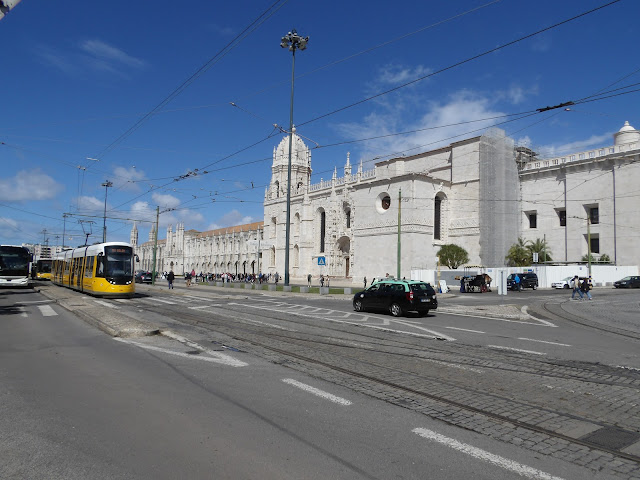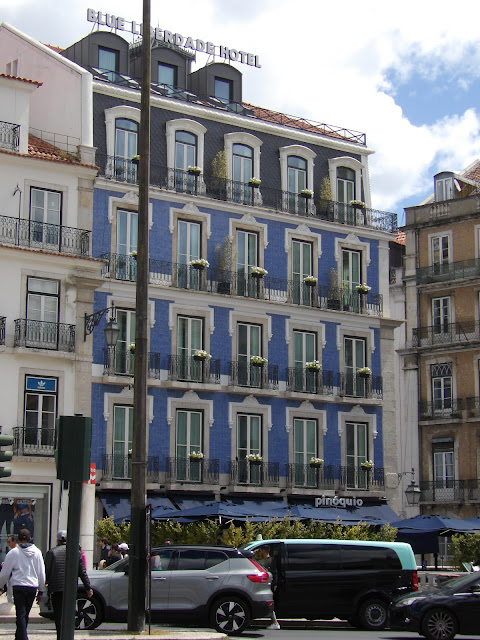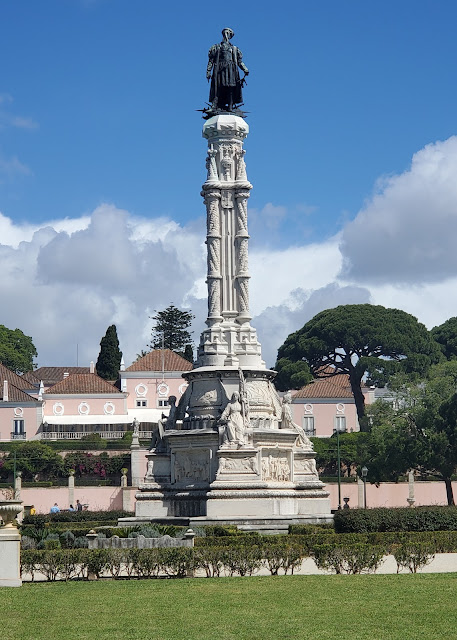Tolin's 2024 World Cruise blog posts, Day 112-13, Apr 30-May 1, 2024, Lisbon, Portugal, Queluz Palace, Sintra, & Seaside Vistas
Lisbon is one of the oldest cities in the world and
the second-oldest European capital city (after Athens),
predating other modern European capitals by centuries. Established by
pre-Celtic tribes and later Phoenicians, Julius Caesar made it a municipium called Felicitas
Julia, adding the term to the name Olissipo. After the fall of the Roman Empire, it was
ruled by a series of Germanic
tribes from the 5th century, most notably the Visigoths. Later
it was captured by the Moors in
the 8th century. In 1147 Afonso Henriques conquered
the city and in 1255 it became Portugal's capital, replacing Coimbra. It
has since been the political, economic, and cultural center of the country.
It has been since the political center of the country, as its
seat of government, National Assembly, Supreme Court of Justice, Armed Forces and residence of the head of state. It is also the center of
Portuguese diplomacy, with ambassadors from 86 countries residing in the city,
as well as representations from Taiwan and Palestine. About 2.9 million people
live in the Lisbon metropolitan area, which
extends beyond the city's administrative area, making it the third largest
metropolitan area in the Iberian Peninsula (after Madrid and Barcelona) as well
as figuring amongst the 10 most populous urban
areas in the European Union. It represents
approximately 27.70% of the country's population.
Lisbon is recognized as an alpha-level global city because
of its importance in finance, commerce, fashion, media, entertainment, arts,
international trade, education, and tourism. Lisbon is amongst the two
Portuguese cities (the other being Porto) to be recognized as a global city, and it
is also home to three companies in the Global 2000 (EDP Group, Galp
Energia and Jerónimo Martins). Lisbon is one of the
major economic centers in Europe, with a
growing financial sector, with PSI-20 being part of Euronext, the
largest center for debt and funds listings in the world. The Lisbon
region has a higher GDP PPP per capita than
any other region in
Portugal. Its GDP PPP amounts to US$179 billion and thus $61,713 per
capita. The city occupies the 40th place of highest gross earnings in the
world and, with almost 21,000 millionaires, is the 11th European city by number
of millionaires and the 14th by number of billionaires. Most of the
headquarters of multinational corporations in
Portugal are located in the Lisbon area.
https://en.wikipedia.org/wiki/Lisbon
Gama Bridge + Tower
View from our cruise ship stateroom
Belém Tower, literally Bethlehem Tower, officially the Tower of Saint Vincent is a 16th-century fortification located in Lisbon that served as a point of embarkation and disembarkation for Portuguese explorers and as a ceremonial gateway to Lisbon. This tower symbolizes Portugal's maritime and colonial power in early modern Europe. It was built during the height of the Portuguese Renaissance, and is a prominent example of the Portuguese Manueline style, but it also incorporates other architectural styles, such as the minarets, which are inspired by Moorish architecture.The structure was built from lioz limestone and is composed of a bastion and a 100 ft, four-storey tower.
Since 1983, the tower has been a UNESCO World Heritage Site, along with the Jerónimos Monastery. It is often portrayed as a symbol of Europe's Age of Discoveries and as a metonym for Portugal or Lisbon, given its landmark status. It has incorrectly been stated that the tower was built in the middle of the Tagus and now sits near the shore because the river was redirected after the 1755 Lisbon earthquake. In fact, the tower was built on a small island in the Tagus river near the Lisbon shore.
https://en.wikipedia.org/wiki/Bel%c3%a9m_Towe
The Jerónimos Monastery or Hieronymites Monastery is a former monastery of the Order of Saint Jerome near the Tagus river in the parish of Belém, in the Lisbon Municipality, Portugal. It became the necropolis of the Portuguese royal dynasty of Aviz in the 16th century but was secularized on 28 December 1833 by state decree and its ownership transferred to the charitable institution, Real Casa Pia de Lisboa.
The Jerónimos Monastery is one of the most prominent examples of the late Portuguese Gothic Manueline style of architecture in Lisbon. It was erected in the early 1500s near the launch point of Vasco da Gama's first journey, and its construction funded by a tax on the profits of the yearly Portuguese India Armadas. In 1880, da Gama's remains and those of the poet Luís de Camões (who celebrated da Gama's first voyage in his 1572 epic poem, The Lusiad), were moved to new carved tombs in the nave of the monastery's church, only a few meters away from the tombs of the kings Manuel I and John III, whom da Gama had served. In 1983, the Jerónimos Monastery was classified as a UNESCO World Heritage Site, along with the nearby Tower of Belém.
https://en.wikipedia.org/wiki/Jer%C3%B3nimos_Monastery
The president of Portugal, officially the president of the Portuguese Republic, is the head of state and highest office of Portugal.
The powers, functions and duties of prior presidential offices, and their relation with the prime minister and cabinets have over time differed with the various Portuguese constitutions. Currently, in the Third Republic, a semi-presidential system, the president holds no direct executive power, unlike his counterparts in the United States and France. However, even though it is in general a ceremonial figure, it holds some powers not that usual in parliamentary systems: one of his most significant responsibilities is the promulgation of all laws enacted by the Assembly of the Republic (parliament) or the Government (an act without which such laws have no legal validity), with an alternative option to veto them (although this veto can be overcome in the case of laws approved by Parliament) or send them to the Constitutional Court for appreciation of whether they violate the Constitution. This and other abilities imply that the president of Portugal does not fit clearly into either of the three traditional powers – legislative, executive and judicial –, acting instead as a sort of "moderating power" among the traditional three.
https://en.wikipedia.org/wiki/President_of_Portugal











































Comments
Post a Comment